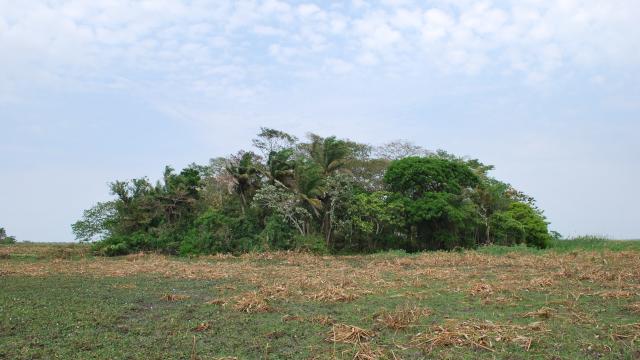Archaeologists have pinpointed four independent regions where humans first began cultivating crops: China, the Middle East, Mesoamerica, and the Andes. We can now add southwestern Amazonia to this exclusive list, owing to new evidence of plant domestication in the region.
Foods made from squash and cassava, a carbohydrate-rich root vegetable, were being consumed in the Amazon over 10,000 years ago, according to new research published today in Nature. That’s kind of a big deal, given that only four other early agricultural hotspots had been previously known.
At the dawn of the Holocene, and as the last ice age faded from humanity’s rearview mirror, cultivated rice appeared in China, grains and legumes in the Middle East, beans and squash in Mesoamerica, and potatoes and Quinoa in the Andes. The new research, led by Umberto Lombard from the University of Bern in Switzerland, points to a fifth early agricultural hotspot: southwestern Amazonia, in what is now Bolivia.
“This is a very important contribution to Amazonian and South American archaeology,” said Jennifer Watling, a microbotanist and archaeologist from the University of São Paulo who wasn’t involved in the new study. “It has long been debated whether the first people that occupied the humid tropics already knew how to cultivate plants. This study provides on-the-ground evidence that they did, at least in southwestern Amazonia,” she told Gizmodo.
The new evidence shows that some of the first people to arrive in Amazonia were quick to take advantage of the natural resources available to them. Scientists aren’t entirely certain when humans first migrated into South America, but archaeological evidence suggests it was as long as 14,600 to 15,600 years ago. That humans had settled into the Amazon by 10,000 years ago is hardly a stretch.
The new evidence was found in Llanos de Moxos, an Amazonian savannah situated in northeast Bolivia. Measuring 126,000 square kilometres, Llanos de Moxos is peppered with unusual features that are all potential evidence of prehistoric human activity, including raised fields, mounds, canals, and forest islands. These “islands” are small, slightly raised areas of dense tree growth surrounded by plains. For the new study, Lombard and his colleagues focused on the forest islands, looking for signs of early cultivation.
Using remote sensing tools, the team mapped the area from above and identified 6,643 individual forest islands, which ranged in size from 0.05 hectares to 16 hectares. Of these, 30 were investigated up-close, in an archaeological technique known as ground truthing. These in-person investigations showed that many of these forest islands were likely former agricultural sites.
At these sites, the scientists dug down and pulled up sedimentary cores for analysis. This allowed them to conduct radiocarbon dating but also gave them access to phytoliths—silica-based particles that form inside plants. The cool thing about phytoliths is that they are shaped according to the specific plant species in which they formed, allowing the researchers to identify the exact crops grown on these forest islands.
“While only 30 of the 6,643 forest plots were analysed for phytoliths, this study represents one of the most extensive landscape-scale reconstructions of past land use and subsistence strategies from the Amazon,” paleoecologist S. Yoshi Maezumi, an honorary research fellow from the University of Exeter, told Gizmodo.
“The consistent presence of a variety of domesticated crops across these soil profiles supports the interpretation that the forest islands were likely constructed and used as home gardens,” said Maezumi, who wasn’t involved with the new research.
Specifically, the researchers found evidence of cassava, also called manioc, squash, and early maize. The cassava was dated to 10,350 years ago, the squash to 10,250 years ago, and the maize to 6,850 years ago. These carbohydrate-rich staples were likely supplemented by large herbivores and fish found in the savannahs, according to the research team, which included scientists from Penn State University, the University of Exeter, and Pompeu Fabra University, among other institutions.
“We already knew from genetic studies that manioc was domesticated some time between 8,000 to 10,000 years ago, so it is the squash evidence that is most surprising,” said Maezumi. “The fact that people were cultivating an already-domesticated squash species by 10,000 years ago implies an even earlier period of pre-domestication cultivation, and it will be extremely interesting to know where this took place.”
Interestingly, the new study also shows that early settlers of southwestern Amazonia were not exclusively hunter-gatherers, having adopted an agricultural lifestyle.
Maezumi said plenty of unanswered questions remain about these early occupations, such as the size of these groups, whether the forest islands were basically gardens, and where these people actually lived.
The new research “places the southwest Amazon among one of the oldest domestication centres in the world,” Watling told Gizmodo. The evidence adds “to an increasing body of evidence that southwestern Amazon was a hotspot for early human occupation and provides new insights on how humans were subsisting and exploiting the diverse resources” in the forest and savannah ecosystem. The diverse landscape, she said, likely played a key role in the process of plant domestication.
“As this region is currently threatened by deforestation and unsustainable land use practices, these data establish the antiquity of human land use in the area and offer an example of over 10,000 years of indigenous land use, plant domestication, and subsistence strategies that can inform sustainable Amazonian futures,” said Watling.
